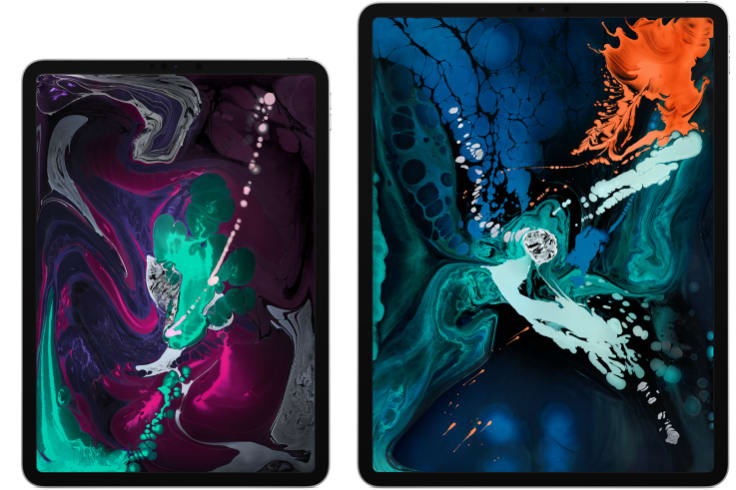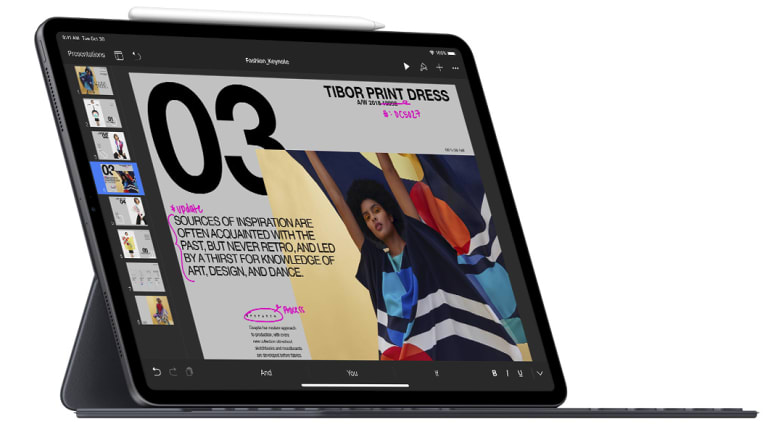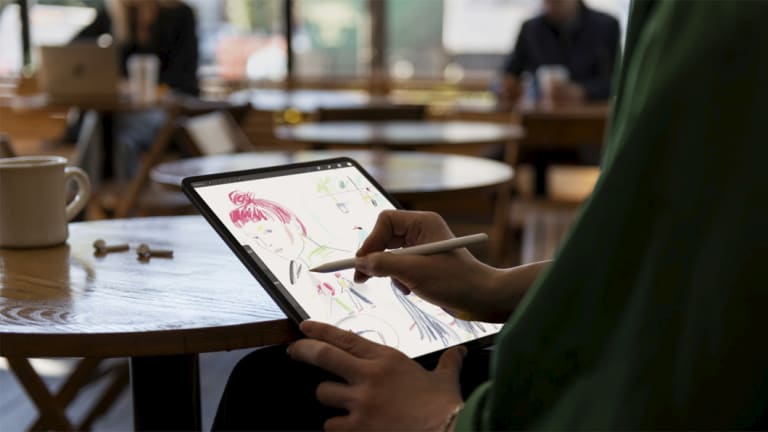
That task is Adobe’s Lightroom, editing large RAW photo images. The iPad Pro applies changes in real time, no lag at all, no matter the change, while my Late 2013 Trashcan Mac Pro (2.7 GHz 12-Core Intel Xeon E5 with 64GB RAM) will stutter and think between any changes. My 2016 MacBook Pro seems to audibly sigh just launching Lightroom. I’ve only had the chance to see “real Photoshop for the iPad” during the hands-on demonstrations, but that was equally impressive. As a long-term Adobe user, I honestly don’t understand how the iPad can perform this well without the RAM I’m accustomed to feeding Adobe products.
All of this is wrapped in a gorgeous design that harks back to the iPhone 5; a wonderful solid case that looks and feels premium. The edge to edge display is fantastic, inheriting all the improvements of previous iPhones and iPads. And it’s great to have Face ID on an iPad, a device that welcomes gestures thanks to its massive screen.
It seems the majority of the press following the device's announcement focussed on the 12.9-inch iPad model. If you’re an artist looking for as big a canvas as possible, it’s an impressive device. Unlike the original 12.9-inch iPad Pro, it doesn’t look comically large in the hand. But I much prefer the 11-inch. The keyboard doesn’t feel cramped at all, and it’s so easy to slip into a bag or use one handed, making it the better tablet while still being big enough for longer periods of work.
Another subtle improvement that pushes the iPad Pro into laptop replacement territory is the switch to USB-C. This new port offers faster transfer of files, as well as support for external monitors and even a USB microphone. But I’m not sure what other peripherals are supported. I doubt you could plug a keyboard (musical or otherwise) into the iPad, and when it comes to files the port is frustratingly only really open to SD cards and direct camera transfers, so don’t expect to work off an external thumb drive or network storage any time soon.

Both are beautiful, but I prefer the smaller iPad Pro.
The Files app has allowed jumping between the silos of Dropbox, Google, Apple and Microsoft a little easier, but not easy enough, and still not as easy as the messy desktop we’ve all grown used to. That’s just one of the frustrations when trying to use the iPad as a computer replacement. As another example it still feels like a lot of extra work to copy a document out of email, work on it, then attach it back and send it again.
And then there’s the terrible enterprise software or clunky old websites we’re all forced to use from time to time, that still won’t behave well on an iPad or any mobile device. But here I put the blame on project managers; if you’re introducing new software in 2018, and it doesn’t work natively on mobile devices, then go back to tender and quit your job. Software is not your calling.
If you’re looking at the Pro you need to also factor the Smart Keyboard Folio and Pencil into the price before purchasing, and keep in mind that combined they cost more than the standard non-Pro iPad. I see no reason to purchase the Pro unless you go all in, and this year both accessories have been greatly improved.
The Smart Keyboard Folio (from $269) feels a lot more solid than Apple’s previous attempts, and is also better than the only third-party keyboard cover worth mentioning, the Logitech Keyboard cover. It snaps on securely, giving the iPad a keyboard worthy of a laptop replacement. The new desktop viewing angle makes the device much easier to use for longer periods, so I can happily type on this device for hours at a time. The Folio adds some protection to the back of the iPad — something missing on previous Smart Keyboards — and the design adds far less bulk to the iPad. It always felt ridiculous to use such a thin device wrapped in a bulky keyboard cover; especially one that flopped around as the older Smart Keyboard did.

The iPad Pro with Pencil and Smart Keyboard attached.
Long story short; until now, all iPad keyboards felt like optional extras, designed after the fact. The Smart Keyboard Folio feels as though it was designed alongside the new iPad, to be used in tandem with it.
Apple’s second generation Pencil ($199) has received modest improvements; it is no more sensitive than last year, but then it was already best in class for precision, angle and sensitivity. The Pencil now charges wirelessly at the top of the iPad, snapping into place with magnets. The magnets are strong enough that the Pencil stayed in place as the iPad bounced around in my bag. It’s a small change, but it means the Pencil is always charged and ready when you need it. I’m not much of an artist, so I rarely used the previous Pencil because it was never charged, and it was never charged because I never used it. It’ll be interesting to see whether the Pencil becomes part of my daily workflow, now it is something I can rely on.

Like the iPhone, the iPad Pro is now essentially all screen.
And you may think it’s evil that Apple makes you purchase the iPad Pro and Pencil and Keyboard separately, but Microsoft does the same with their Surface. Don’t hate the player, hate capitalism. It is unfortunate that the change to a new port means the older Apple Pencil will not work with the new iPad Pro.
Overall, I really want to replace my current laptop with this iPad Pro, and when you look at it that way the asking price seems less absurd. But I still can’t just yet, and that all comes down to software. Yes, real Photoshop is coming. I would argue Office for iPad is better than the Mac version, certainly PowerPoint and Outlook are. And the multi-tasking changes in iOS 11 helped make the iPad all the more useful, but there’s still a way to go. Having any two apps side by side helps, but I also want two windows of the same app, side by side. And multitasking is still a little cumbersome to use, and to exit out of.
Loading
Multitasking was always going to be difficult to introduce to a platform that purposely ignored the concept for nearly a decade. I get that, but I’m sure there’s a way of balancing iOS simplicity with macOS versatility.
The iPad Pro’s hardware feels years ahead of everything else, but the software still feels a little behind.
The smart money is on new software features being announced at WWDC in June, but I would never recommend purchasing a product with the idea that a software update down the track will make it more useful. Evaluate the product yourself, on the hardware and software available, not on what you think might be coming.
And as it stands, there are still too many little tasks I find more difficult to perform on the iPad than on my much more boring, old, slow, less pretty computer.
I’m just worried Apple has priced the iPad Pro out of the hands of the people who would get the most from it; artists using the Pencil for instance. So often, in recent years, the "Pro" moniker on Apple devices feels like it should be replaced by “Executive”, or “Luxury”, and unless you can replace your laptop and a Wacom tablet with the iPad Pro, then I feel the device falls into the luxury camp. There is no way I can afford this device, and as long as I can’t replace my laptop with it, there is no way to convince my boss to buy one for me either.
Peter Wells works at Swinburne University and is a technology commentator in his spare time. He is an award-winning journalist who currently appears on the Daily Tech News Show.









 Add Category
Add Category